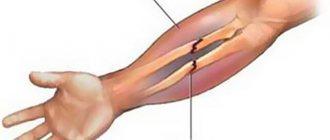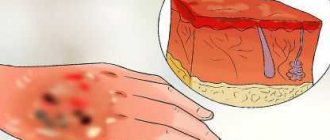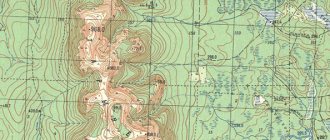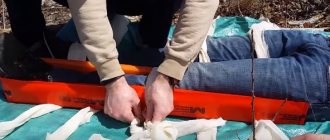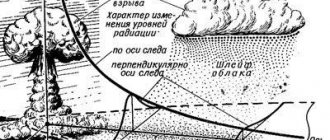Technological progress does not stand still. However, its rapid development often negatively affects not only the health and well-being of the people themselves, but also the environmental situation.
Every year, due to the growth of weapons, the development of science, space exploration and the expansion of industrial production, the number of objects emitting radiation increases.
There are only 3 sources of radiation hazard on the planet:
- Space including natural radioactive radiation
- Dangerous background left after nuclear tests
- Operation of facilities containing radioactive or ionizing substances, including storage and disposal of hazardous waste.
Accidents at these facilities, even minor ones, can lead to devastating consequences that will not be so easy to eliminate. How to act if such a situation arises and whether it is possible to protect yourself by living in a radioactively contaminated area - we will consider in this article.
What kind of accident is this and why is it dangerous?
On the territory of Russia there are approximately several hundred operating fixed radiation hazardous objects. These include various fuel processing enterprises, storage facilities, nuclear power plants, and nuclear military facilities. In addition, there are various devices that operate using radionuclide sources.
Any breakdown, theft, sabotage, or leak can cause an emergency situation involving the loss of life and poisoning of nearby natural objects. Storage facilities in which large volumes of toxic substances are concentrated pose the greatest danger due to the formation of larger radiation accident zones.
Such an emergency situation is considered to be any event that led to sudden irradiation of people, as well as environmental pollution with the obligatory excess of permissible values established by regulations.
On this topic ▼
Explosion
Effects of the shock wave and damaging factors
The causes of radiation accidents may be human factors (worker errors, violation of instructions, sabotage, equipment failure) or natural (natural disasters).
The main damaging factors of radiation accidents at any facility are radiation and contamination of the territory with dangerous poisonous particles. The danger of infection lies in the ability of any type of radiation to have a destructive effect on the atoms of the environment where they are located. As a result, a change in its structure, composition, and tissue occurs, which leads to irreparable disturbances in life.
As a result, people experience the following lesions:
- Steam explosions cause burns, skin damage and injuries.
- Radiation sickness. The severity and outcome depend on the radiation dose received.
- Long-term consequences, expressed in shortened life, the occurrence of tumors, decreased immunity, infertility, genetic mutations in subsequent generations.
The severity of the harmful health effects depends not only on the dose received, but also on the time during which the person was in the danger zone and exposed to radiation.
We recommend watching an interesting video - it can be used for teaching!
After the alarm clears
Any chemical attack is temporary. Toxic elements are either neutralized or dispersed into the air. Until the affected area is declared safe, leaving the shelter is strictly prohibited.
When leaving a contaminated area, you should remove protective clothing. It is advised to take a shower, thoroughly rinse exposed skin and eyes, and rinse the mouth.
The risk of poisoning remains even if precautions are taken. If alarming symptoms appear, it is recommended to temporarily limit physical activity, take plenty of fluids, and consult your doctor. First aid involves washing the affected areas, removing toxins from the body, and stabilizing vital signs.
Residential premises are thoroughly cleaned using a wet method and other consequences of a chemical attack are eliminated. It is prohibited to consume water from wells and centralized water supplies. Food grown in gardens should not be consumed until it is determined to be suitable for food.
We recommend reading: Product disposal act: sample form
Lesions
The facility itself where an accident with the release of radioactive substances occurred, as well as the adjacent territories, including buildings, communication structures, enterprises, settlements, where the level of radiation contamination exceeds ³ 2mR/h, becomes a source of damage.
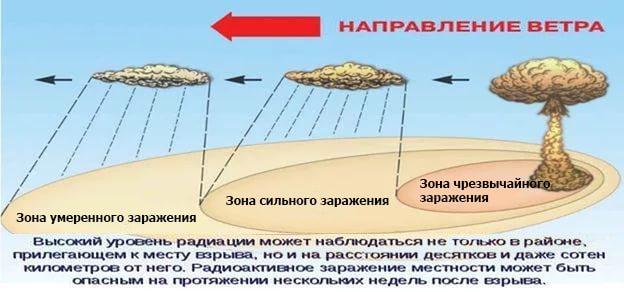
Contamination zones due to radiation damage
Depending on the degree of damage in this focus, 3 zones are distinguished:
- In areas with levels of more than 2-5 mR/h, strict control is established. In this area, the radiation dose is constantly monitored, the population is given individual anti-radiation protective equipment, and special treatment of the area is carried out.
- An area with a level of 5-20 mR/h is a resettlement zone. All animals and people are evacuated, radiation reconnaissance is carried out around the clock, food is delivered only in sealed special containers.
- Where P > 20 mR/h is officially designated as an exclusion zone. This territory is fenced with special wire, people are resettled to another place of residence.
At the borders of all identified hazardous areas, special signs warning of the presence of radiation must be installed.
First chemical attack
The first time mustard gas was used in a chemical attack was during the First World War by German troops. The poisonous substance was released from the cylinders when the wind blew towards enemy positions. Gas was used for the first time, which is why the soldiers did not have personal protective equipment. Due to their effectiveness, the new weapons were used repeatedly, resulting in casualties on both sides of the conflict.
Chemical attacks were later widely used during World War II and the Vietnam War. In the 21st century, toxic substances were sprayed in Iraq and Syria.
Since 1993, the development, production, and proliferation of chemical weapons has been prohibited by the convention. As of 2020, 92% of reserves of toxic substances of mass destruction have been destroyed in Russia.
The use of chemical weapons leads to the contamination of a separate area of the area. Citizens in the affected area are required to follow the basic rules of behavior and precautions during attacks. This reduces negative consequences and reduces the number of losses.
Methods of protection and your actions
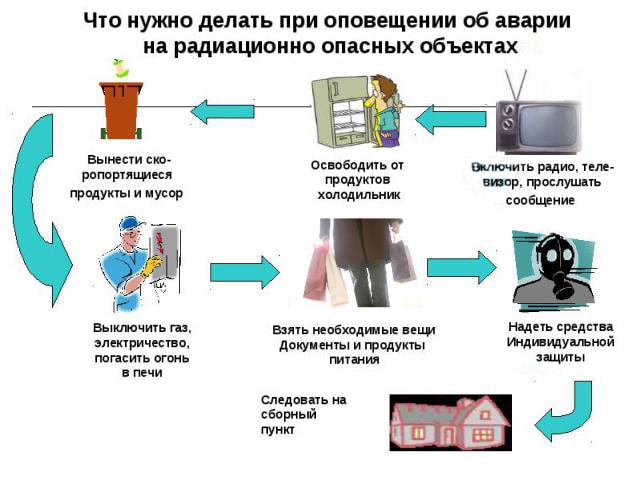
Actions in case of a radiation accident
If you fall into a radiation accident zone, there are only 3 options for action that need to be taken:
- Limit the time spent in a given area to a minimum
- Protect yourself with special protective equipment or use protective structures that absorb radiation
- Evacuate from the contaminated area
If you were in an open area at the time of the release of chemicals, immediately close your breathing system and take shelter in any building.
On this topic ▼
Composition of the emergency suitcase
Let us consider in more detail how to behave indoors in the event of a radiation accident.
- Close the vents and windows. Turn on the TV or radio to get all the information you need. Follow the instructions you hear.
- If you were outside, be sure to take a shower and pack your clothes tightly in a bag. Drink plenty of fluids.
- You should fully stock your first aid kit with everything you need in advance. If someone in your family suffers from a chronic disease, then it is necessary that the necessary medications are available in sufficient quantities.
- If it is impossible to leave your home, you should begin sealing it. Pay special attention to cracks, ventilation, window frames, and chimneys.
- Take iodine supplements.
- Always use a gauze bandage, respirator or mask. To improve the filtering properties of homemade protective equipment, moisten them with water.
When an evacuation is announced, do not go outside without respiratory and skin protection. Additionally, pack the backpack with things in plastic. At home, turn off all electrical appliances and check the taps and gas equipment. Be sure to register with the evacuation officer before departure.
Prevention and protection measures in case of radiation accident
Infections
Preventive and protective measures for various types
Topic 42
Lecture 23
A radiation accident is an accident at a radiation-hazardous facility, leading to the release or release of radioactive substances and (or) ionizing radiation beyond the boundaries specified by the design for the normal operation of this facility in quantities exceeding the established safety limits of its operation.
A person located in a contaminated area is exposed to: external radiation from the effects of a radioactive cloud and radioactive substances deposited on the area; contact irradiation of complex integuments when they are exposed to radioactive substances; internal exposure from inhaling contaminated air and consuming contaminated food and water.
Under the influence of ionizing radiation, biological processes arise in the human body, leading to disruption of the vital functions of various organs (mainly the hematopoietic organs, nervous system, gastrointestinal tract, etc.).
The main measures to prevent and reduce the effects of damaging factors during a radiation accident are:
· notifying the population about the accident and informing them about the procedure to act in the current conditions;
· sheltering people in protective structures;
· use of personal protective equipment;
· preventing the consumption of contaminated food and water;
· evacuation of the population;
· restriction of access to non-contaminated areas.
Protection measures in case of radiation accidents are:
· protect the respiratory system with protective equipment - a gas mask, a respirator, and in their absence - a gauze bandage, a scarf, a towel moistened with water;
· close the windows and doors, turn off the ventilation, turn on the radio, radio, TV and wait for further instructions;
· cover food items in. plastic bags, store water in containers with tight-fitting lids; place food and water in the refrigerator, cabinets, pantries, do not eat vegetables, fruits, water stored after the accident;
· strictly observe the rules of personal hygiene;
· prepare for a possible evacuation, collect documents, money, food, medicine, personal protective equipment;
· take cover when the command arrives in the nearest protective structure.
Evacuation remains the main method of protection against radiation.
The number of people to be evacuated is determined each time by local authorities, taking into account the recommendations of the Main Directorate for Civil Emergency Situations, based on the conditions, nature and scale of the emergency.
Another method of protection is special treatment
Special treatment is a set of measures to eliminate contamination of the population with radioactive, hazardous chemicals or bacterial agents. This complex involves the use of various methods and means of disinfection, i.e. decontamination, degassing, disinfection.
There is partial and complete special processing.
Partial special processing means mechanical cleaning and processing of exposed skin, outer surfaces of clothing, shoes, and personal protective equipment. It is carried out in the contaminated area, is in the nature of a temporary measure and is aimed at preventing the danger of secondary infection of people.
Complete special treatment is the disinfection of the entire human body with disinfectants, treatment of mucous membranes, washing, changing linen and clothes. It is mandatory for everyone after leaving the infection zone. It is carried out at stationary washing points (SOPs) and special sites deployed for this purpose. Parts of the body, the head and the skin of the body are wiped with a disinfectant solution. After washing, people go to the dressing department, where the mucous membranes of the eyes, nose and mouth are treated. Clothes and shoes are also issued here after disinfection or from the exchange fund, as well as respiratory protection equipment.
Decontamination is the removal of radioactive substances from certain areas of the area, structures, transport, clothing, food, water, human body and other objects to acceptable contamination standards. It is carried out using mechanical and physical-chemical methods.
The mechanical method is the removal of radioactive substances from the surface (sweeping away contaminated objects with brushes and other improvised means, shaking, beating out clothes, washing with a stream of water, etc.). This method is the most accessible and can be used immediately after leaving the contaminated area.
However, decontamination only by mechanical means will be ineffective in the case of close contact of radioactive substances with the surface of many materials, when the adhesion forces are quite high.
The physico-chemical method of decontamination is the use of solutions of special preparations that increase efficiency; washing away radioactive substances.
To obtain a solution, the powder is added to water in small portions with constant stirring.
Partial decontamination is organized by the population themselves after leaving the contaminated area and is carried out using the simplest mechanical methods - shaking, beating out using brushes, brooms and sticks. As a result of double treatment, contamination is reduced by 90 - 95%. However, if clothes and shoes are wet, then the degree of infection decreases by only 30%.
After decontamination, each item is subjected to repeated radiation monitoring, and if the level of contamination is higher than permissible standards, then the work is carried out again.
Decontamination of clothing and footwear should be carried out using reliable protective equipment (gas masks, respirators, cotton-gauze bandages, protective suits).
Complete decontamination of clothing and footwear is carried out in stationary washing points (SOPs) equipped with appropriate installations and instruments.
Mechanical washing decontaminates clothes and other items made of cotton, linen and wool fabrics in a special mode with the addition of a 0.5% solution of surfactants OP-7, OP-10 and washing powders. Clothing or footwear that cannot be completely decontaminated is stored in designated areas in order to reduce the degree of contamination to established limits.
In the event of an accident, the degree of ionization of the environment by natural and artificial sources of radiation is assessed. Depending on the degree of ionization of the environment, the radiation situation can be normal (dose rate up to 0.6 μSv/h (60 μR/h)), abnormal {dose rate from 0.6 to 1.2 μSv/h (60..120 μR /h)1 and radioactively contaminated (dose rate more than 1.2 μSv/h (120 μR/h)],
Monitoring the radiation situation is an integral part of monitoring the state of the environmental situation and consists of conducting radioecological monitoring (observation and assessment of the actual radiation situation), predicting its development and, based on these data, by comparing with control data and determining the need to take measures to protect the population and territories and normalize situation.
Monitoring of the radiation situation is carried out constantly throughout the country by the forces and means of the Unified State Environmental Monitoring System, RSChS of various levels, interested ministries and departments, units for monitoring and monitoring radiation hazardous objects (P00).
Particular attention is paid to radiation monitoring of radioactive waste at the stages of construction, operation (especially in emergency situations) and during their decommissioning. Based on the results of monitoring the radiation situation during accidents at radioactive waste facilities, measures to protect the population are determined on the basis of the “Methodology for determining measures to protect the population during accidents at nuclear power plants.” Assessment of the actual radiation situation during its monitoring is carried out using instruments, systems and radiation monitoring equipment (Table 5).
The main radiometric instruments include the DP-5V dose rate meter, which is designed to measure the levels of gamma radiation and radioactive contamination (contamination) '„. various objects by gamma radiation. This device can also detect beta contamination. Gamma radiation measurement range from 0.05 mR/h to 200 R/h Using this device, you can conduct reconnaissance of the radiation situation.
For individual monitoring of people's exposure for the purpose of primary diagnosis of radiation injuries, a set of individual dose meters ID-11 is used, which provides measurement of the absorbed dose of gamma and mixed gamma neutron radiation in the range from 10 to 1500 rad.
In addition, the industry produces various household dosimeters that allow the population to independently assess the radiation situation in their places of residence or location." (“Bella”, “Berg”, etc.).
